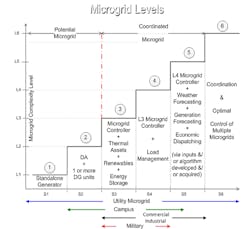PGE Plans Customer, Community Microgrids as Part of Energy Storage Pilot
Portland General Electric (PGE) has filed plans with state regulators to develop customer-sited and community microgrids in response to a state energy storage mandate that could reap big benefits to the utility and its customers.
Filed with the Oregon Public Utility Commission, the proposal calls for two to five microgrid pilot projects. The filing responds to House Bill 2193, which mandates that PGE procure at least 5 MWh of energy storage by 2020.
A report from Navigant included in the filing (UM1856) identified the potential benefits of energy storage to PGE. Navigant found that under a number of different use cases, the benefits distributed across all customers vary from about $200/kW to nearly $3,000/kW over 10 years, on a net present value basis. Benefits to one specific customer range from $0/kW to more than $2,400/kW, said the Navigant report.
“These benefits are considered in light of energy storage system (ESS) costs in PGE’s Energy Storage Proposal, which considers proposed deployments of energy storage systems at
specific locations on PGE’s network,” said the Navigant report.
PGE’s microgrid projects are intended to serve as models for replicable community programs, as well as microgrids to meet customer demand for resilient systems.
The utility will develop two types of microgrid projects, said the filing. One will be a single customer microgrid, which will serve a single customer metered site. That might be a single building, facility or campus. The customer involved will have on-site generation that will allow it to go off grid during an outage.
A community microgrid — or partial feeder microgrid — will serve customers on one feeder. A segment of the feeder will be isolated during an outage. “This could be a neighborhood or otherwise closely located facilities on the same feeder section,” said the filing.
As many as five microgrids will be developed during the pilot project, in combination with customers’ new or existing distributed energy resources.
Tests variety of microgrid use cases
“The pilot will evaluate communities and customers at critical facilities with and without solar and dispatchable standby generation in order to test a variety of energy storage/microgrid use cases for resiliency,” said the filing.
During normal operations, PGE will control and operate the energy storage for grid services. During outages, the energy storage devices and distributed energy resources will disconnect from the grid in order for the customer or community to get power.
PGE designed the pilot with an eye toward testing the technical viability of microgrids, looking at microgrids’ ability to dispatch grid services, island from the grid, reconnect to the grid and provide integrated load management within the microgrid.
The pilot projects will leverage PGE’s existing dispatchable standby generation program, which manages 122 MW of customer-owned backup generation. PGE sees its dispatchable standby generation program as a simple form of microgrid, and plans to compare the benefits of this existing program to an “optimized network of microgrids,” said the filing.
The filing quoted S&C Electric’s definition of six different levels of microgrid sophistication — beginning with something as simple as PGE’s dispatchable standby generation program. The most complex microgrid has “multiple forms of generation, energy storage, sophisticated controller capabilities and even the ability to coordinate multiple microgrids,” the filing said.
Credit: S&C Electric
“In order to appropriately leverage the microgrid investment, PGE will need an energy storage control system capable of controlling the microgrids as they increase in sophistication,” said the filing.
The pilot projects will include automated switching systems and control that will allow PGE to use energy storage devices for a number of different functions — within community microgrids for capacity, energy, ancillary services and asset deferral.
Way to meet clean energy goals
Customers who agree to have PGE develop microgrids on their sites will have access to energy storage and generation as a back-up resource during outages or emergencies.
PGE noted that the state recently passed legislation calling for utilities to meet 50 percent of its customers’ needs with renewable energy by 2040.
“If we are going to meet these clean energy goals, we will need to incorporate energy storage as a key part of our energy strategy,” said PGE in the filing, noting that the utility is experiencing increased demand from customers for resilient power systems.
“Energy storage technologies can provide a range of grid services to provide resiliency as well as support PGE’s transition to a clean energy future,” said PGE.
Track news about community microgrids. Subscribe to the free Microgrid Knowledge newsletter.
About the Author
Lisa Cohn
Contributing Editor
I focus on the West Coast and Midwest. Email me at [email protected]
I’ve been writing about energy for more than 20 years, and my stories have appeared in EnergyBiz, SNL Financial, Mother Earth News, Natural Home Magazine, Horizon Air Magazine, Oregon Business, Open Spaces, the Portland Tribune, The Oregonian, Renewable Energy World, Windpower Monthly and other publications. I’m also a former stringer for the Platts/McGraw-Hill energy publications. I began my career covering energy and environment for The Cape Cod Times, where Elisa Wood also was a reporter. I’ve received numerous writing awards from national, regional and local organizations, including Pacific Northwest Writers Association, Willamette Writers, Associated Oregon Industries, and the Voice of Youth Advocates. I first became interested in energy as a student at Wesleyan University, Middletown, Connecticut, where I helped design and build a solar house.
Twitter: @LisaECohn
Linkedin: LisaEllenCohn
Facebook: Energy Efficiency Markets

